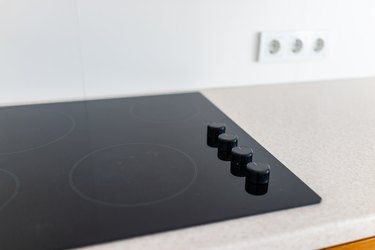
The shiny surface of a glass cooktop creates a clean, slick backdrop in the kitchen. It provides a modern and sleek look when it's clean and primed for creating stovetop dishes.
Removing white spots and grease from a glass cooktop takes some finesse to ensure that the gleaming surface isn't damaged by the cleaning process. Glass cooktops are easy to clean and maintain if done on a regular basis and with the right cleaning supplies and methods.
Video of the Day
Video of the Day
What Causes Discoloration
There are many ways a glass cooktop gets peppered with white spots or puddles of discoloration. If there are visible stains on the glass cooktop, heating and using the appliance can set them and make them harder to remove.
The white spots on a glass cooktop are more than likely from hard water deposits. Hard water is one of the most common problems for cleaning. Luckily, these can be quickly removed with a few swipes of vinegar or another gentle, natural homemade solution.
Discoloration on glass cooktops can be due to oily or colored liquids left too long on the surface of the ceramic work surface. Spices like curry or turmeric can leave yellow stains behind if they aren't quickly wiped away from the surface of the glass cooktop. Sugary spills can solidify and leave an ugly mark as well, so Molly Maid recommends wiping these up before they have a chance to set.
Commercial Cooktop Cleaners
There are many over-the-counter cleaners that are safe to use on a dirty cooktop. When the cooktop is caked with grime and grease, a gentle application of a ceramic cooktop cleaner can cut through the layers of grease. Consult the owner's manual, which will often recommend the best brand of commercial cooktop cleaner to use for that specific model.
It doesn't take much ceramic cooktop cleaner to remove layers of cooking residue. Use a soft sponge without any abrasive sides to work the cleaner into the surface of the cooktop. Let it sit for 15 minutes before wiping away with a wet sponge. Buff dry with a clean, soft cloth.
For more stubborn stains like burnt-on food or plastic that was accidentally melted on the cooktop, work at the stains with a plastic scraper held at a 45-degree angle using gentle pressure and smooth strokes. Remove any melted and burnt plastic immediately before it has a chance to adhere to the glass cooktop surface.
Vinegar to Clean a Cooktop
A white or black glass-top stove with discoloration can typically be returned to its pristine condition with a good cleaning. White vinegar works well to take down layers of grease or saucy spills. Its acid base will eat through grease, but it's gentle enough not to damage the cooktop.
Fill a spray bottle with vinegar and spritz the glass cooktop until it's soaked. Leave this on the surface for 15 minutes and allow the vinegar to eat at the grime and grease. Rinse well and buff dry with a clean cloth.
Glass Stove Top is Peeling
The top of the thick glass cooktop can peel if harsh cleaners are left for a lengthy period on the surface. Although it may seem like a good idea, CNET recommends that you don't use glass cleaners. Glass cleaners with ammonia can damage the surface and be too strong for the heating element. This can lead to discoloration or peeling if left too long on the glass cooktop surface.